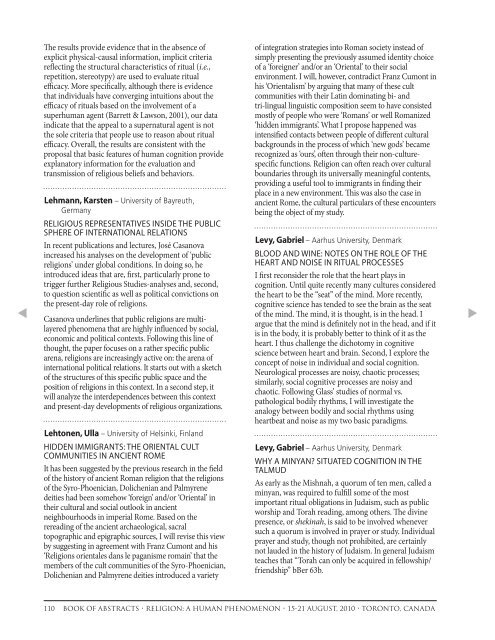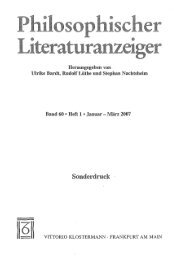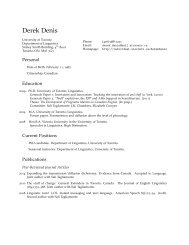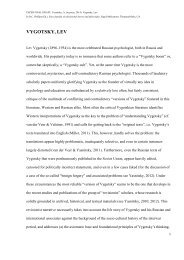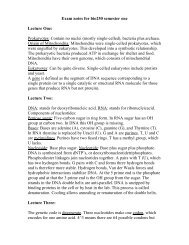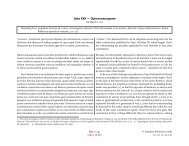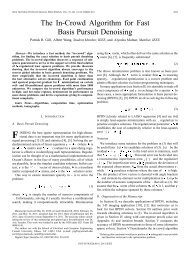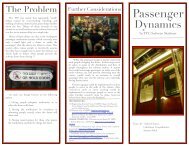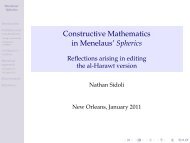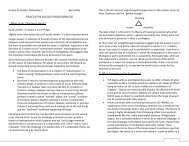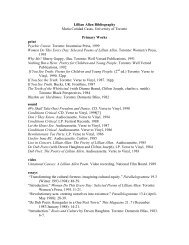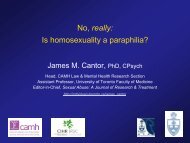BOOK of ABSTRACTS XXTh WORld COngReSS InTeRnATIOnAl ...
BOOK of ABSTRACTS XXTh WORld COngReSS InTeRnATIOnAl ...
BOOK of ABSTRACTS XXTh WORld COngReSS InTeRnATIOnAl ...
You also want an ePaper? Increase the reach of your titles
YUMPU automatically turns print PDFs into web optimized ePapers that Google loves.
The results provide evidence that in the absence <strong>of</strong><br />
explicit physical-causal information, implicit criteria<br />
reflecting the structural characteristics <strong>of</strong> ritual (i.e.,<br />
repetition, stereotypy) are used to evaluate ritual<br />
efficacy. More specifically, although there is evidence<br />
that individuals have converging intuitions about the<br />
efficacy <strong>of</strong> rituals based on the involvement <strong>of</strong> a<br />
superhuman agent (Barrett & Lawson, 2001), our data<br />
indicate that the appeal to a supernatural agent is not<br />
the sole criteria that people use to reason about ritual<br />
efficacy. Overall, the results are consistent with the<br />
proposal that basic features <strong>of</strong> human cognition provide<br />
explanatory information for the evaluation and<br />
transmission <strong>of</strong> religious beliefs and behaviors.<br />
Lehmann, Karsten – University <strong>of</strong> Bayreuth,<br />
Germany<br />
religious rePresentatives inside tHe PuBlic<br />
sPHere <strong>of</strong> international relations<br />
In recent publications and lectures, José Casanova<br />
increased his analyses on the development <strong>of</strong> ‘public<br />
religions’ under global conditions. In doing so, he<br />
introduced ideas that are, first, particularly prone to<br />
trigger further Religious Studies-analyses and, second,<br />
to question scientific as well as political convictions on<br />
the present-day role <strong>of</strong> religions.<br />
Casanova underlines that public religions are multilayered<br />
phenomena that are highly influenced by social,<br />
economic and political contexts. Following this line <strong>of</strong><br />
thought, the paper focuses on a rather specific public<br />
arena, religions are increasingly active on: the arena <strong>of</strong><br />
international political relations. It starts out with a sketch<br />
<strong>of</strong> the structures <strong>of</strong> this specific public space and the<br />
position <strong>of</strong> religions in this context. In a second step, it<br />
will analyze the interdependences between this context<br />
and present-day developments <strong>of</strong> religious organizations.<br />
Lehtonen, Ulla – University <strong>of</strong> Helsinki, Finland<br />
Hidden immigrants: tHe oriental cult<br />
communities in ancient rome<br />
It has been suggested by the previous research in the field<br />
<strong>of</strong> the history <strong>of</strong> ancient Roman religion that the religions<br />
<strong>of</strong> the Syro-Phoenician, Dolichenian and Palmyrene<br />
deities had been somehow ‘foreign’ and/or ‘Oriental’ in<br />
their cultural and social outlook in ancient<br />
neighbourhoods in imperial Rome. Based on the<br />
rereading <strong>of</strong> the ancient archaeological, sacral<br />
topographic and epigraphic sources, I will revise this view<br />
by suggesting in agreement with Franz Cumont and his<br />
‘Religions orientales dans le paganisme romain’ that the<br />
members <strong>of</strong> the cult communities <strong>of</strong> the Syro-Phoenician,<br />
Dolichenian and Palmyrene deities introduced a variety<br />
<strong>of</strong> integration strategies into Roman society instead <strong>of</strong><br />
simply presenting the previously assumed identity choice<br />
<strong>of</strong> a ‘foreigner’ and/or an ‘Oriental’ to their social<br />
environment. I will, however, contradict Franz Cumont in<br />
his ‘Orientalism’ by arguing that many <strong>of</strong> these cult<br />
communities with their Latin dominating bi- and<br />
tri-lingual linguistic composition seem to have consisted<br />
mostly <strong>of</strong> people who were ‘Romans’ or well Romanized<br />
‘hidden immigrants’. What I propose happened was<br />
intensified contacts between people <strong>of</strong> different cultural<br />
backgrounds in the process <strong>of</strong> which ‘new gods’ became<br />
recognized as ‘ours’, <strong>of</strong>ten through their non-culturespecific<br />
functions. Religion can <strong>of</strong>ten reach over cultural<br />
boundaries through its universally meaningful contents,<br />
providing a useful tool to immigrants in finding their<br />
place in a new environment. This was also the case in<br />
ancient Rome, the cultural particulars <strong>of</strong> these encounters<br />
being the object <strong>of</strong> my study.<br />
Levy, Gabriel – Aarhus University, Denmark<br />
Blood and Wine: notes on tHe role <strong>of</strong> tHe<br />
Heart and noise in ritual Processes<br />
I first reconsider the role that the heart plays in<br />
cognition. Until quite recently many cultures considered<br />
the heart to be the “seat” <strong>of</strong> the mind. More recently,<br />
cognitive science has tended to see the brain as the seat<br />
<strong>of</strong> the mind. The mind, it is thought, is in the head. I<br />
argue that the mind is definitely not in the head, and if it<br />
is in the body, it is probably better to think <strong>of</strong> it as the<br />
heart. I thus challenge the dichotomy in cognitive<br />
science between heart and brain. Second, I explore the<br />
concept <strong>of</strong> noise in individual and social cognition.<br />
Neurological processes are noisy, chaotic processes;<br />
similarly, social cognitive processes are noisy and<br />
chaotic. Following Glass’ studies <strong>of</strong> normal vs.<br />
pathological bodily rhythms, I will investigate the<br />
analogy between bodily and social rhythms using<br />
heartbeat and noise as my two basic paradigms.<br />
Levy, Gabriel – Aarhus University, Denmark<br />
WHy a minyan? situated cognition in tHe<br />
talmud<br />
As early as the Mishnah, a quorum <strong>of</strong> ten men, called a<br />
minyan, was required to fulfill some <strong>of</strong> the most<br />
important ritual obligations in Judaism, such as public<br />
worship and Torah reading, among others. The divine<br />
presence, or shekinah, is said to be involved whenever<br />
such a quorum is involved in prayer or study. Individual<br />
prayer and study, though not prohibited, are certainly<br />
not lauded in the history <strong>of</strong> Judaism. In general Judaism<br />
teaches that “Torah can only be acquired in fellowship/<br />
friendship” bBer 63b.<br />
110 BOOk Of ABstRACts • RELIGION: A HUMAN PHENOMENON • 15-21 AUGUst, 2010 • tORONtO, CANAdA


